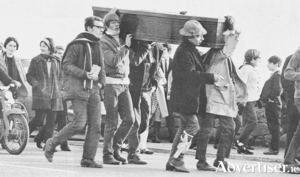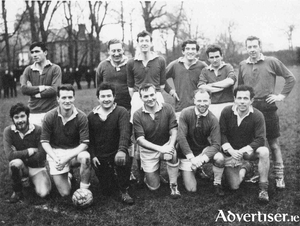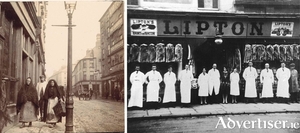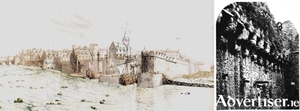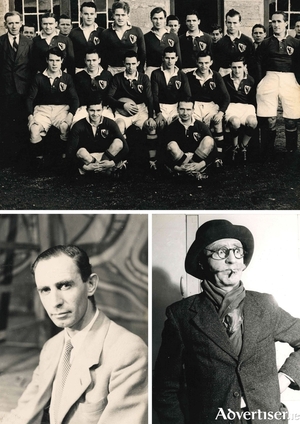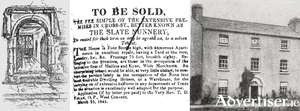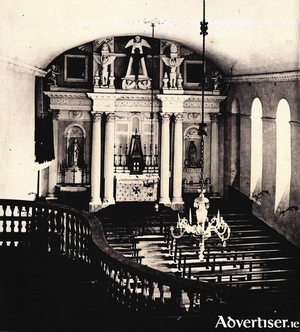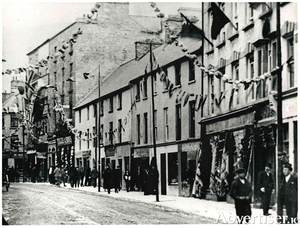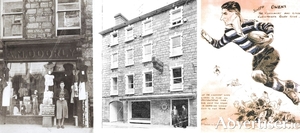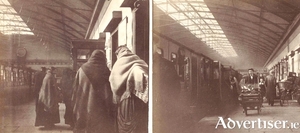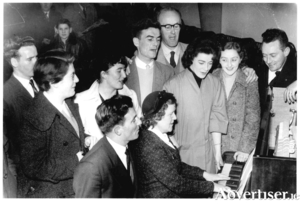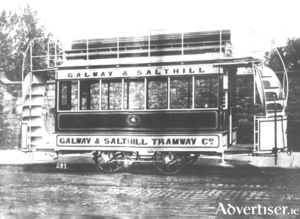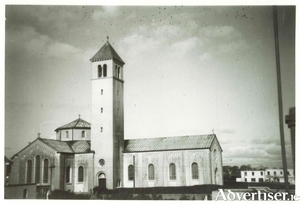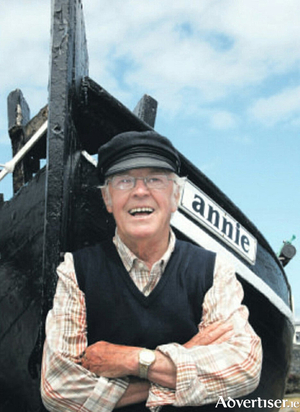A medieval castle in Quay Street
Thu, Jun 13, 2024
Blake’s Castle is a medieval urban fortified town house at the bottom of Quay Street which was built c1470 with single bay ground and first floors and a two-bay second floor. It has a flat roof with a crenelated parapet with a projecting machicolation on supporting corbels on the top floor above the entrance. This was an opening at the parapet through which defenders could drop material such as boiling water or hot pitch down on would-be attackers. It was built with coursed roughly dressed limestone rubble walls with square headed window openings to the upper floors.
Read more ...St. Joseph’s Special School — the early years
Thu, Jun 06, 2024
On October 28 1961, the following letter appeared in the Connacht Tribune --- “Sir, Educational facilities for mentally handicapped children are entirely inadequate in this country and except for the excellent work of the religious orders, the problem would be of much greater magnitude……………. Would anybody be interested in doing something for mentally handicapped children in Galway? Signed PARENT OF A MENTALLY HANDICAPPED CHILD”
Read more ...St. Mary’s College — the early days
Thu, May 30, 2024
It was about this time of year, May 26, 1910 that the foundation stone of St. Mary’s College was laid. It was not, however the first St Mary’s College. Father John Paul O’Toole, born in Galway in 1804, was one of the last priests ordained during the wardenship. He was based in Paris and Rome but was always conscious of his own difficulty in obtaining a food secondary education in Galway, so he decided to return to Galway in 1843 and open a school here. His main difficulty was finding a premises but happily, he managed to secure “West House”, a detached residence with extensive grounds situated on Helen Street. He bought it from John Lushington Reilly, a great benefactor of the town and neighbourhood, especially during the famine of 1822.
Read more ...Swimming in Salthill
Thu, May 23, 2024
Swimming is the self-propulsion of a person through water as a form of recreation, exercise or survival. It has numerous health benefits and is good for all ages and all levels of fitness. It is among the top public recreational activities. One can swim in the sea, the lake or river.
Read more ...Sixty years of the Students' Union
Thu, May 16, 2024
The University College Galway Students' Union was originally established in 1911 as the Students' Representative Council. This council lasted only a short time but its reestablishment was proposed in 1913 and by the 1920s, it was firmly established. In the 1960s, it was formally developed into the University Students' Union, then known as Comhairle Teachta na Mac Leinn or CTM for short. It was formed in 1964, the function of the union as per the constitution was “to represent its members and promote, defend and vindicate the rights of its members at all levels of society.”
Read more ...College staff exhibition
Thu, May 09, 2024
Our first photograph today is of Mrs Anne Creaven, or “Ma” Creaven as she was known to generations of students and staff at UCG. She ran the coffee shop, a small intimate split level building which had originally been the College Sports Hall. It could only cater for a small number of people at one time, but student numbers were small in college then.
Read more ...Liptons in Shop Street
Thu, May 02, 2024
Our first image today is a beautiful study of part of Shop Street c1900. It is one of a number of Galway city photographs that are in an old album belonging to Norman Healy whom we thank for sharing it with us. The two women in the foreground are in their working clothes, plain black shawls and práiscíns which were heavy canvas working aprons used to carry vegetables or maybe fish in, or wear when they were washing clothes. One is carrying a basket which probably contained product she had to sell, possibly eggs, country butter or vegetables. The other lady may have had a basket strapped to her back. The gentleman behind is wearing an impressive white báinín jacket.
Read more ...The end of an era
Thu, Apr 25, 2024
The Ó Máille family originally came from Portacarron near Oughterard which accounted for their Irish speaking background. Their landlord, Mrs Annie Nolan evicted them from their holding and they spent a number of years in temporary accommodation. When Mrs Nolan’s son wanted to run in an election, Isaac Butt, the Irish Parliamentary Party leader stipulated that his nomination would not be ratified until such time as his mother reinstated her evicted tenants and so the Ó Máille family were awarded a fine farm holding in Brackloon in the parish of Corofin, east of the Corrib.
Read more ...The end of an era
Wed, Apr 24, 2024
The Ó Máille family originally came from Portacarron near Oughterard which accounted for their Irish speaking background. Their landlord, Mrs Annie Nolan evicted them from their holding and they spent a number of years in temporary accommodation. When Mrs Nolan’s son wanted to run in an election, Isaac Butt, the Irish Parliamentary Party leader stipulated that his nomination would not be ratified until such time as his mother reinstated her evicted tenants and so the Ó Máille family were awarded a fine farm holding in Brackloon in the parish of Corofin, east of the Corrib.
Padraic Ó Máille did an extensive apprenticeship working in Castlebar, before he, his brothers Seán and Stiofán together with their sister Mary (known to all as Cis) commenced trading at Number 54, Dominick Street in 1938. They used to cycle into Galway every morning and home again in the evening. They had the imagination and foresight to develop trade in home-spun yarns, hand-woven tweed and made-to-measure clothing. Pádraic was the first businessman in Ireland to buy and sell traditional hand-knitted goods.
Read more ...Our fortified city
Thu, Apr 18, 2024
The town of Galway was virtually an independent city state, self-contained politically and ecclesiastically, relying on its own resources as it was cut off from the central English authority until the 16th century. Then, the Tudors began to extend their influence westwards so that the city gradually came totally under their dominion. The real symbol of that growing influence was the fortifications, four in number, raised to defend this all-important location against all enemies, notably France and Spain.
Read more ...Cyril Mahony, a superb comic actor
Thu, Apr 11, 2024
Cyril Mahony was born in February 1913 in the family home on Prospect Hill. His mother was Mary Teresa Cunniffe from Loughrea and his father Gerry was a member of the RIC who at one time was stationed in Belfast. He eventually left the force and came back to his mother’s house on Prospect Hill. She was Anne Flaherty from Conamara, a native speaker and a well-known maternity nurse.
Read more ...The Dominican nuns in Galway
Thu, Apr 04, 2024
The first Dominican Nunnery in Galway was founded 380 years ago, in 1644 in New Tower Street, now known as St Augustine Street. They were honoured with a visit from Papal Nuncio Rinucinni three years later. When the Cromwellians took over the city, the sisters were faced with two alternatives, to renounce their religious life and return to their families, or exile. They choose the latter and left for Spanish monasteries.
Read more ...Galway Dominicans, a brief history
Thu, Mar 28, 2024
The Dominican Order was formally approved by Pope Honorius III in 1216, “to witness to the truth of the Christian Faith and to proclaim it at home and abroad”. St Dominic died in 1216, and in 1224 the Dominicans first came to Ireland. They came to Connacht, to Athenry, in 1241, and they finally arrived in Galway in 1488.
Read more ...Cunningham’s butcher shop
Thu, Mar 21, 2024
This superb image of Martin Cunningham’s butcher shop at Number 10, Shop Street was taken c.1900. In the 1901 census, the occupants of this building are listed as Martin Cunningham, aged 50; his wife Delia aged 30 and their children Michael aged 12, Mary Margaret 7, James 3, Delia 2 and Martin J. who had just been born. The family lived over the shop.
Read more ...The Atlanta Hotel
Thu, Mar 14, 2024
Joseph Owens lived in Glenamaddy with his wife, who was born Annie M Tuohy. They had three children, Dick, Mary, and her twin Joseph (born February 4, 1912), who was known to one and all as Josie. The father died very young. Annie remarried, this time to a man named Doorly, and in 1922, the family bought a four-bay four-storey early 19th century house in Lower Dominick Street from Nora O’Donnell and moved to Galway. Annie was a busy woman, she opened a drapery shop where she designed clothes, made them and sold them in her shop, and she kept lodgers upstairs, all as she was rearing her children.
Read more ...Galway Railway Station
Thu, Mar 07, 2024
The station opened on August 1, 1851. The buildings and the Great Southern Hotel were designed by John Skipton Mulvany. It was originally planned to have the station at Renmore, but the well-known Father Peter Daly convinced the railway authorities to construct Lough Atalia Bridge and bring the trains into the centre of town. The fact that he owned tenement buildings on the site where the Great Southern was built may well have had something to do with it. These tenements were levelled to make way for the hotel and station.
Read more ...The Patrician Musical Society
Thu, Feb 29, 2024
On this day, February 29, 1952, a meeting was held in the Bish the purpose of which was, “That a choral society titled the Patrician Choral Society under the auspices of the Patrician Brothers Past-Pupils’ Union be here and now formed.” The motion was proposed, seconded and passed unanimously. Jack Browne was elected President, Thomas Lydon as Vice-President, Jack Doherty and Brother Cuthbert as directors and Jack Begley as Treasurer.
Read more ...The Galway and Salthill Tramway Company
Thu, Feb 22, 2024
The mid-19th century was an era of little movement of people for social or pleasure purposes. In the post-Famine era, it was only business people of necessity, those who were emigrating or those whose financial circumstances allowed who travelled. Railway travel had come Galway in 1851 and there were a few horse drawn omnibuses operating between the city and the village of Salthill, which was really a rural backwater. But, it was becoming a fashionable place to live and was developing as a tourist destination. It was therefore no surprise when a tramway system between the city and the village was proposed.
Read more ...The Church of Christ the King
Wed, Feb 14, 2024
Around the year 1930, there were about 400 residents in Salthill and it was attracting large number of visitors and tourists who came in the summer. There was provision at the time for the building of some 100 homes. The population was growing but there was no church in the area. Any resident or tourist who wished to go to Mass had to travel into the Jesuit Church or St Joseph’s, or out west to the chapel in Barna.
Read more ...The King of the Claddagh
Thu, Feb 08, 2024
James Hardiman, the Galway historian, wrote the following in 1820, “This colony has from time immemorial been ruled by one of their own body, periodically elected. This individual, who is dignified with the title of Mayor, in imitation of the head municipal officer of the town, regulates the community according to their own peculiar laws and customs, and settles all their fishery disputes. His decisions are so decisive, and much respected that the parties are seldom known to carry their differences before a legal tribunal, or to trouble the legal magistrates”.
Read more ...



